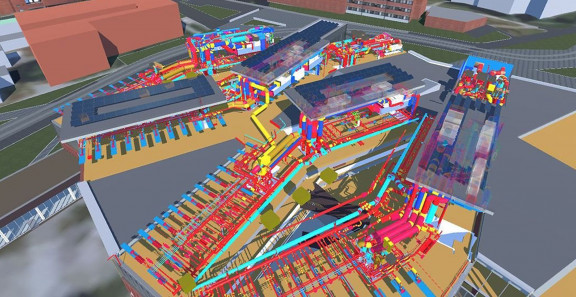This article was originally published in Helsingin Sanomat’s Ideat supplement on 21 September 2020
An accurate 3-D model facilitates property maintenance and major renovations. Buildings can be automatically monitored, just like a modern factory.
The conference attendees are yawning – and no wonder. From the 3D image, the property manager can see that the conference room has suddenly changed from green to red. There is an unacceptable accumulation of carbon dioxide in the air. The ventilation unit is flashing yellow in the image, and the application suggests both reasons and solutions for the machine’s abnormal functionality.
This is how a building’s digital twin could work. It makes a detailed analysis of both users’ needs and the operation of technical systems.
“A digital twin supports owners, users and maintenance personnel alike. It’s particularly beneficial for larger properties with many kinds of facilities whose usage requirements are difficult to forecast, such as hospitals, commercial centres and offices,” says Marko Tulamo, Head Of Department at Sitowise.
Even the best property manager cannot singlehandedly monitor the hundreds of devices connected to a building’s technical systems, let alone analyse their functionality in respect to each other.
Marko Tulamo, Head of Technical Building Systems, Sitowise
Monitoring leads to better energy efficiency
Tulamo expects that automatic monitoring will lead to better energy efficiency in buildings. As part of a smart city, a building’s digital twin could also automatically negotiate with a neighbour when there is surplus solar energy to transfer or store.
“Smart buildings will play a key role in achieving carbon neutrality in cities.”
At Sitowise, a digital twin is based on a 3D data model that accurately reflects the dimensions of the property and also displays a view of the inside of its walls and floors. The model shows all of the pipes and cabling, identifies materials, and provides product information in both words and images.
“The data model contains static data that is updated only when the building’s structures are altered. A digital twin is born when rapidly changing dynamic data is added to this model. This data comes from sources such as technical building systems and property users,” says Tulamo.
The homebuyer’s helper
Data models are already familiar tools for designers and builders, and YIT even gives homebuyers the chance to see a 3D model of their apartment that illustrates their material choices. Data models are also being refined to aid maintenance personnel.
“The complexity of the maintenance model depends on the client. For example, at the Mall of Tripla, the remote control and monitoring of technical building systems has been linked to its maintenance model,” says Marko Oinas, Vice President, Strategy & Development at YIT Housing Finland.
Sitowise has noticed that large owners, such as the State and cities, have been keen to model their properties in recent years.
However, actual digital twins are only just being tested. For Tulamo, one challenge is that there are still no common standards for the data collected from different systems.
However, the current challenges in standardisation do not prevent the sector’s professionals from envisioning the future.
A digital twin could also take advantage of augmented reality. A property manager could walk along wearing augmented reality glasses and be able to see where the ducts and valves are located in the walls and ceilings.
-Marko Oinas, Vice President, Strategy & Development, YIT.
Data models are also beneficial in existing buildings
When an apartment building is preparing for pipeline, façade or yard deck renovations, you need to determine how well the old blueprints correspond to reality.
Rooms are measured, ducts are opened, construction materials are identified, and pipes are photographed. And if this pile of papers gets left on the previous contractor’s or property manager’s desk – or seems unreliable – the same procedure will be repeated for the next renovation.
Tomi Valkeapää, Head of Renovation Services at Sitowise, encourages housing companies to switch to a digital 3D model that can store all these measurements and be updated to reflect any changes.
“The data model can be created either gradually or all in one go during a major renovation. In either case, it’s a good idea to start with laser scanning, as it measures room dimensions to a high degree of accuracy. Accurate data will be of considerable help later on, in renovations carried out by both the housing company and shareholders, and will also be reflected in the costs.”
Valkeapää encourages offices, schools, daycare centres and service buildings to start modelling, even if there are no major renovations coming up.
“A model is an important tool for planning changes in how facilities are structured or used.”
